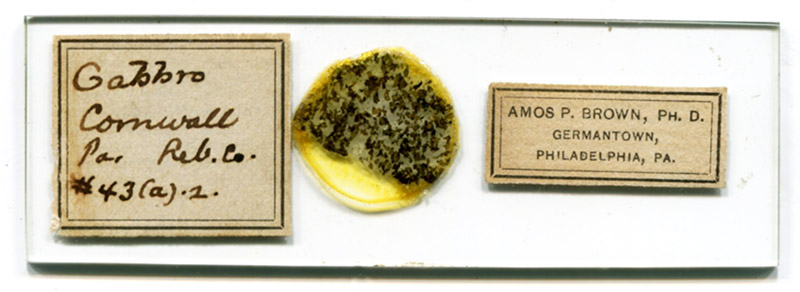
Figure 1. A thin section of gabbro, from Cornwall, England, by Amos P. Brown.
Amos Peaslee Brown, 1864 - 1917
by Brian Stevenson, with Witmer Stone
last updated June, 2021
Amos P. Brown, Ph.D., was a Professor of Mineralogy and Geology at the University of Pennsylvania, Philadelphia. This was a time when a scientific man would often have a broad base of knowledge. For example, Brown’s colleague, Edward D. Cope, was initially a Professor of Mineralogy and Geology at the University, then later switched to Professor of Zoology and Comparative Anatomy. Many of Brown’s surviving microscope slides are of geological specimens (Figures 1 and 2). However, he was well versed in several other scientific fields, and slides of non-geological objects may be found (Figures 3-6).
I have not found any records of Brown selling his slides, or broadly offering them for exchange. Presumably, then, surviving slides came from Brown’s personal collection or from donations/exchanges with colleagues and societies. In that vein, during 1919 Brown’s family presented the Academy of Natural Sciences of Philadelphia with “the microscopical collection of Dr. Amos P. Brown, including a Queen Acme microscope, a Leitz mineralogical microscope, a Beck petrographical microscope, twenty-four objectives, a series of accessories and an object cabinet containing about twelve hundred mounted objects”.
Of note, there was another A.P. Brown who was active in Philadelphia microscopy circles at the same time as Amos Brown. Albert P. Brown (1840-1892), was a pharmacist and Lecturer on Microscopy at the Philadelphia College of Pharmacy. This Professor Brown operated a pharmacy at the corner of Fifth and Federal Streets, Camden, New Jersey. In 1878, he was a founding member of the Camden Microscopical Society.

Figure 1.
A thin section of gabbro, from Cornwall, England, by Amos P. Brown.

Figure 2.
A mineral mount by Amos P. Brown, a specimen of chalcotrichite from Cuba. The specimen is mounted inside a brass device, the lid of which keeps out dust yet can be removed for observing the mineral. See Figure 8 for a microscopic view of the specimen.

Figure 3.
A mount of Orbiculina, from an expedition on the "Albatross". The specimen is mounted inside a brass container, as per Figure 2, on a metal slide. Pictures courtesy of Ted Bernhardt.

Figure 4.
A microscope slide of Spirillum undula, stained to reveal flagella, dated 1891. Brown published on ‘staining bacteria to demonstrate the flagella’ in 1892, which described the bacteria, mordant, and stain listed on this slide’s labels. See Figure 9 for a microscopic view of the specimen.
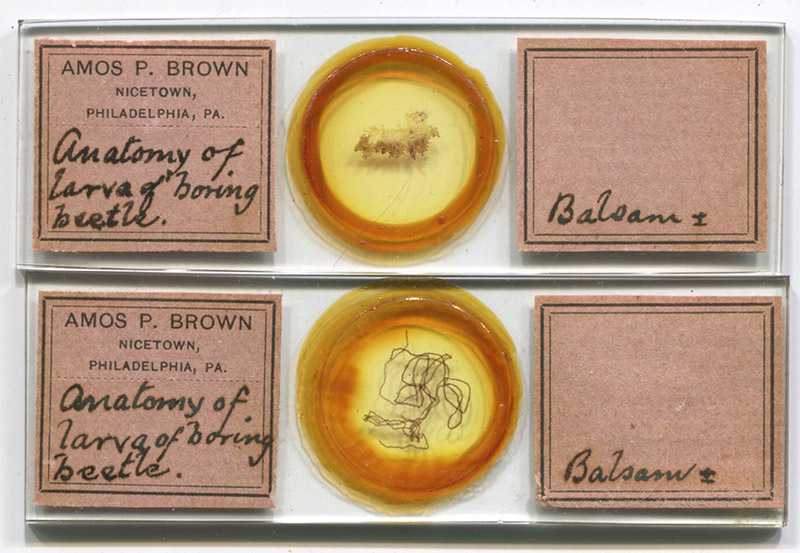
Figure 5.
Two entomological preparations by Brown. Both are pieces of a dissected "diving beetle".
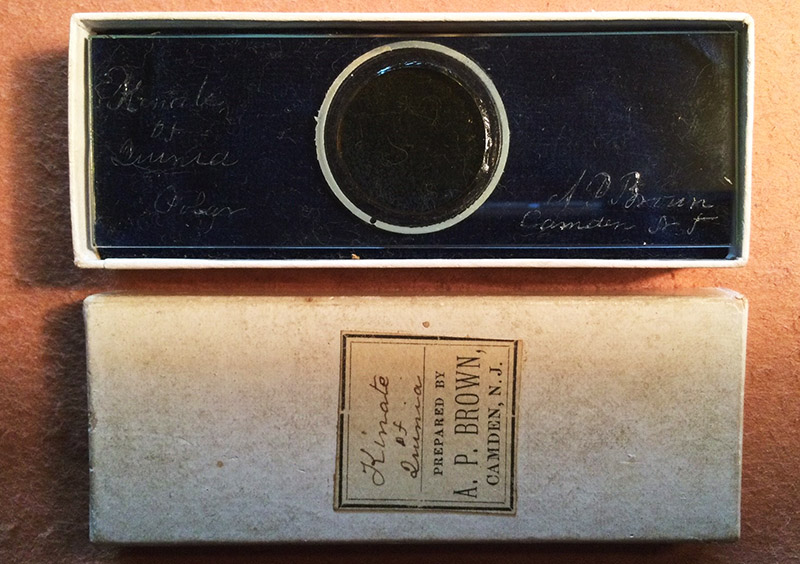
Figure 6.
An A.P. Brown slide of "kinate of quinia" (quinine), with its labeled box. Picture courtesy of Tom Schwan.
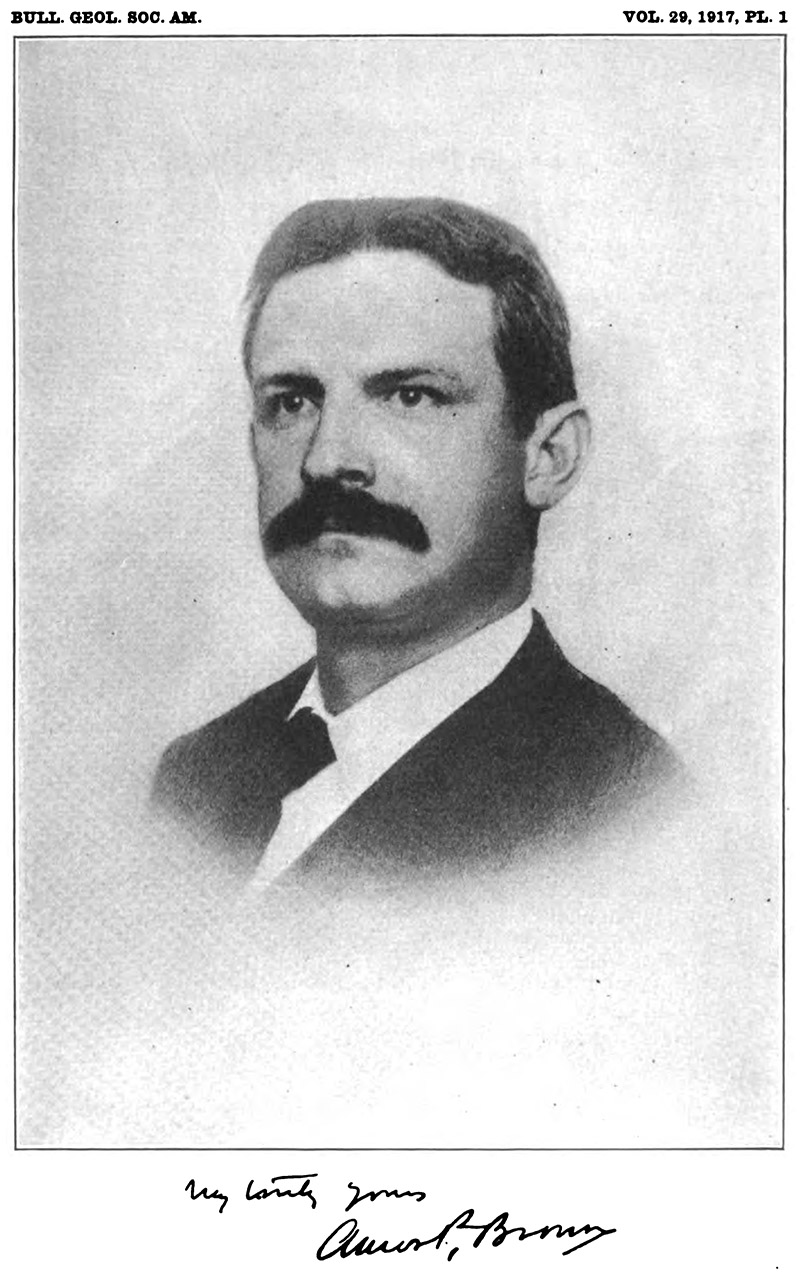
Figure 7.
Undated photograph of Amos Peaslee Brown, from his obituary that appeared in “The Bulletin of the Geological Society of America”.
After Brown’s death, his close friend, Witmer Stone, wrote a memorial for the Proceedings of the American Philosophical Society, providing details of his personal life and professional works. It is provided here as the best possible description of the microscopist:
Amos Peaslee Brown was born in Germantown, Philadelphia, on December 3, 1864, the son of Amos Peaslee and Frances Brown and the fourth child of a family of seven sons and two daughters. His parents were cousins. His paternal grandfather, also Amos Peaslee, had settled in Maryland, where he was engaged in agriculture, while his grandfather on his mother's side, Jeremiah Brown, with two other brothers, Moses Brown and David S. Brown, had established themselves in Philadelphia as dry-goods commission merchants, founding one of the first business houses of this sort in the city.
The ancestor of the family in America was Henry Brown, who in 1639 had emigrated from England to Haverhill, Massachusetts, and who became one of the early settlers of Salisbury in the same state. Jeremiah Brown married Elizabeth Stewardson, sister of Dr. Thomas Stewardson, a well-known medical practitioner of Philadelphia and a man of broad scientific knowledge, a member of the Academy of Natural Sciences and a botanist of considerable standing. If we seek for the origin, in past generations, of the love of science so strongly marked in Dr. Amos Brown, we shall probably find it traceable to the Stewardsons.
Brown's earliest education was received at a small private school, but in the autumn of 1877 he entered the Germantown Academy, which had that year been placed in charge of a new and deservedly popular principal, Dr. William Kershaw. At school, Amos Brown was always at the head of his class. He was one of those fortunate boys who seem able to master their studies with very little effort, and was always especially proficient in mathematics. At the close of his second year he received the phenomenal average of 100 in each of the subjects in which the class was examined. Deciding to take a scientific course in college, he did not study Greek and dropped Latin in his last years at school. He was thus able to combine two years' work in one and graduated in June, 1882, entering the University of Pennsylvania in the following autumn. He took the Towne Scientific Course, specializing in mining engineering after the sophomore year and graduated in June, 1886. He remained at the university another year, pursuing his studies in the post-graduate course in mining, and received his degree of E.M. in June, 1887.
Soon after graduation, Brown secured a position as aide on the Second Geological Survey of Pennsylvania, under the late Charles A. Ashburner, then assistant geologist of the survey, and also assistant on the United States Geological Survey, in charge of coal statistics. He worked here in the bituminous region until June 18, 1888, when he returned to Philadelphia and accepted a position under Mr. Benjamin Smith Lyman, who had undertaken a survey of the New Boston and Morea coal lands in Schuylkill County, near Pottsville. The survey was a private enterprise, but the map was afterward published by the State Geological Survey. This work kept Brown in the field until late in the autumn, while the actual drawing of the map was done in Philadelphia in the winter. In the following, spring Mr. Lyman engaged in a survey and report on the “New Red" formation of Bucks and Montgomery counties, in which Brown again acted as his assistant and prepared an account of the igneous rocks of the district, which accompanies Mr. Lyman's report. His name appears on both the Bucks County map and that of the Morea anthracite district as first assistant.
In the early autumn of 1889, before the Bucks County survey was completed, Brown left Mr. Lyman to accept a position as instructor in mining at the University of Pennsylvania, under his old professor, Dr. Koenig, and here he remained for practically the rest of his life.
Soon after his return to the university he began studying for the degree of Doctor of Philosophy, which was conferred upon him at the commencement on June 16, 1893.
In 1890 he was instructor in mining and metallurgy; in 1892 professor of mineralogy and geology in the auxiliary department of medicine, which he held until the abolishment of the department in 1898.
On March 5, 1895, he became assistant professor of mineralogy and geology in the college faculty, and full professor in the spring of 1903, a position which he continued to hold until the spring of 1917, when he was forced to resign on account of failing health.
From the autumn of 1892, after Dr. Koenig's retirement from the University, Brown took over the entire direction of the department, teaching in all branches of the subject - mineralogy, geology, lithology, crystallography, mining and metallurgy.
While not at all averse to field work, Brown's duties at the University were exceedingly congenial. He liked teaching, and the association with other scientific men was very enjoyable, while, established at his home once more, he was able to pursue his various researches to his heart's content.
After he returned to Philadelphia, Brown became a frequent visitor to the Academy of Natural Sciences, and on January 27, 1891, he became a member. For several years he was one of the most regular attendants at the weekly meetings. He joined the Microscopical and Biological Section of the Academy, where he was distinctly in his element. The association with men who were devoted to this, his favorite study, he enjoyed to the utmost; while they found in him a man remarkably well informed upon the whole field of microscopical research. At the beginning of 1892 he was chosen director of the section, a post which he held for two years. He later became a member of the committee on the award of the Hayden Medal serving until his death, while in 1897 and again from 1900 to 1905 he delivered the lectures on geology and mineralogy in the Ludwick Free Courses at the Academy.
During the time of his first activity at the Academy of Natural Sciences, he became closely associated with Edward D. Cope, who was then professor of mineralogy and geology - later of zoology and comparative anatomy - at the University of Pennsylvania, and who thoroughly appreciated Brown's ability and broad knowledge. In the summer of 1893, having arranged for an exploration of some of the fossil beds of the west in the interests of the Academy, Cope invited Brown to become his associate on the trip, an invitation which he eagerly accepted. Their explorations began at Bismarck, N.D., on July 10, and covered parts of both North and South Dakota, the Cimarron River District of Oklahoma, the northeastern border of the Staked Plains of Texas and portions of Kansas, coming to a close on September 4, at Galena, Mo. Cope paid especial attention to the fossil vertebrates, while Brown devoted himself to the invertebrates. The results of the reconnaissance are set forth in a paper by Cope in the Proceedings of the Academy, in which will be found several notes credited to Brown.
Up to this time Brown had enjoyed excellent health. He possessed an iron constitution and had therefore never found it necessary to exercise any care whatever in the matter of exposure or overwork. Now, however, possibly from overtaxing his strength on the western trip, he suffered a severe attack of illness, followed in 1895 by another similar attack. This made him very cautious about exposing himself and he seldom went out at night, giving up almost entirely the evening meetings at the Academy, and not until 1901 did he again take part to any extent in the scientific activities of the city, except in connection with his duties at the University.
On May 17, 1901, he was chosen a member of the American Philosophical Society and at once became interested in its meetings, as he had been in those of the Academy ten years before. He served on several of the committees and on January 3, 1908, was elected one of the secretaries, an office which he continued to hold until his death. He was a regular attendant at the meetings, except when prevented by failing health, and was a painstaking, faithful and loyal officer.
He joined several other societies, but took no active part in their proceedings. He was elected a member of the American Institute of Mining Engineers on February 24, 1888; a member of the Franklin Institute in April, 1890; a member of the American Association for the Advancement of Science in 1901, and a fellow in 1906; a fellow of the Geological Society of America on December 27, 1905, and a member of the American Museum of Natural History in December, 1916. He was also a charter member of the Pennsylvania Chapter of the Society of the Sigma Xi and a trustee of his old school, the Germantown Academy.
In August, 1902, he took a cruise along Labrador coast, and camped for several weeks at Dove Point, at the head of Sandwich Bay. He made a valuable collection of the flowering plants of the region for the Academy's herbarium but devoted his attention mainly to geological problems and to a study of the general geology and topography of the country, and the grosser features of the fauna and flora. He had the faculty of storing away such general observations, made on his various trips, and holding them at his command for immediate use in future discussions or comparisons.
In 1904 he made a reconnaissance of the central Rocky Mountains for the purpose of investigating certain mining properties and in the succeeding years made one or more similar trips to Utah, Nevada and Oregon, continuing on to San Francisco on one occasion, where he investigated with intense interest the effects of the great earthquake.
Up to 1900 Amos Brown had published comparatively little. There was an early boyhood paper on the tiger beetles, published anonymously in an amateur journal, and in 1888 an admirable account of the "Modes of Occurrence of Pyrite in Bituminous Coal," prepared while engaged on the State Survey. In this he recognized five forms of occurrence and traced the origin of the pyrite to the iron content of decomposing plants affected by the sulphur from gypsum or hydrogen sulphide. Nodular pyrite he suggested was formed from fish remains in the same way; while attention is called to the present-day formation of pyrite in the scum seen on stagnant pools. In 1894 he published "A Comparative Study of the Chemical Behavior of Pyrite and Marcasite," which was his thesis for the degree of Doctor of Philosophy. This is distinctly a piece of chemical research, dealing with the relative oxidation of sulphur in these two mineral forms of FeS, by various solutions, as well as the solubility of the iron in various acids. There were two short papers in 1891 and 1892 in which the early spiral form of Baculites is described for the first time, the former of which was reprinted in scientific journals both of this country and in London. He published the first definite account of the crystallization of molybdenite in 1896 and in 1898 a scholarly account of "Jade and Other Green Stones," which was a summary of a lecture given at the Museum of Science and Art of the University of Pennsylvania. There were several short notes on microscopical and geological subjects published in 1896 and 1897 and the notes in Lyman's report and in Cope's paper already referred to.
In 1901 he also brought out a new edition of Erni's well-known textbook, Mineralogy Simplified, which was used by his classes at the University. Part II of this work was entirely rewritten, while Part III, on "Physical Determinative Mineralogy," was wholly original and reflects Brown's views on the importance of sight identification of minerals.
In 1904 Brown began work upon what was to prove his greatest contribution to science, a piece of research, the far-reaching importance of which has perhaps not even yet been fully appreciated. Dr. Edward T. Reichert, professor of physiology in the medical department of the University of Pennsylvania, had begun in 1902 some investigations as to the differentiation and specificity of corresponding proteins and other vital substances in relation to biological classification and organic evolution. He had come to the his assistant and prepared an conclusion that the hemoglobins of animals offered excellent possibilities in this line of investigation and also that their characters could best be compared and their relationships ascertained through a study of their crystallography. "Not being an authority in the science of crystallography," wrote Dr. Reichert, "I associated with me in 1904, one of my colleagues, Professor Amos Peaslee Brown, upon whom has fallen that portion of the work which demanded the services of an expert crystallographer." The enormous amount of work that Brown contributed to the undertaking can thus be readily appreciated by anyone who consults the portly volume, embodying the results of the investigation, which was issued in 1909 by the Carnegie Institution of Washington, under whose grant the prosecution of the work was made possible. Several preliminary reports on the progress of their work were issued by Professors Reichert and Brown, one of which was presented at the general meeting of the American Philosophical Society, in the spring of 1908. The hemoglobin investigation involved the crystallization and examination of hemoglobin from the blood of over one hundred species of animals and the preparation of 2,500 photomicrographs, 600 of which appear in the report along with upwards of 400 outline drawings. Briefly the investigation shows that the crystals from the several species of a genus all belong to one crystallographic group - those of the cats (Genus Felis) for instance, being isomorphous just as strictly as are the rhombohedral carbonates among minerals. Specific characters are also evident in the differences in the angles of the crystals. The importance of such facts in considering the relationship of species and genera and in the whole field of phylogeny will readily be appreciated.
The constant application incident to this protracted piece of research and the severe strain which it entailed were too much for Brown, and in the summer of 1909 he suffered a severe nervous breakdown, which necessitated a complete rest from his duties at the University, during the next college year.
He took a trip to Jamaica in February, 1910, his first experience in the tropics, and became so much interested in the natural history of the island that he returned for another visit in April, passing on this time to Panama, where he studied the geological formations exposed in the canal cuts and discovered some interesting beds of fossils from which he made valuable collections. The study of these upon his return to Philadelphia showed them to be of such importance that he was led to make still another trip in August for the purpose of securing additional material.
Brown brought his collections to the Academy of Natural Sciences, and with the assistance of Dr. Henry A. Pilsbry, the noted malacologist, began to work them up for publication. For the next three years a large part of his spare time was spent in Dr. Pilsbry's quarters at the museum. The latter, being actively engaged in publication, stimulated Brown to prepare many papers which would probably never have appeared had he been left entirely to himself, since he was always skeptical as to the importance of his researches and the advisability of publishing the results. In several instances Dr. Pilsbry gave him the benefit of his vast knowledge of the mollusca, in working up the systematic portion of the reports, and they were published under their joint authorship. Thanks to Dr. Pilsbry's advice and stimulation Brown published more papers during this period than in all the rest of his career.
As joint authors they prepared in 1911 a paper on "The Fauna of the Gatun Formation, Isthmus of Panama," based upon Brown's collections of the previous year. In the introduction he explains that the study of the specimens fully bore out his impression, formed during a hasty reconnaissance of the exposures along the Canal and railway, that the several shell-bearing formations which have been given distinctive names really all belong to one stratigraphic unit. He and Dr. Pilsbry moreover agree that this is more likely to prove to be Oligocene than Eocene, as Dall has regarded it, and call attention to its resemblance to the Santo Domingo beds studied by Gabb. Thirty-seven new species were described in this paper, while thirty-three more were named in two supplementary publications, based upon material obtained by Professor W.B. Scott, in 1911.
Brown was also associated with Dr. Pilsbry in a report on a collection of fossils from Wilmington, N.C., which was received at the Academy about this time, while he published independently an account of some new Cycads and Conifers which were sent to the museum from the "New Red" formation of Bucks County, Pa., a region with which he had become very familiar during his association with Mr. Benjamin Smith Lyman, on the State Survey.
Another important paper was prepared from data collected on his Labrador trip nine years before, entitled, "The Formation of Ripple Marks, Tracks and Trails." He had found that the broad clay and sand flats of Sandwich Bay, Labrador, which were covered by shallow water at high tide, exhibited wonderful series of ripple marks which bore a striking resemblance to those seen in the Triassic rocks. He immediately began a minute study of the water action in order to ascertain just how they were formed, and discovered that they were of two kinds - caused respectively by deposit and erosion. The many tracks and marks on these clay beds were also carefully studied and many of them proved practically identical with certain tracks and trails in the Connecticut Trias described by Hitchcock as those of annelids, fishes, etc., to which he had given distinctive names on the basis of these tracks. Brown found that a pebble to which a large sea-weed (Ulva) was attached made a perfect "annelid" trail, the sea-weed buoying it up and allowing it to drag slowly along on the bottom. Pieces of other sea-weeds and bits of spruce boughs rolled along by the water produced other tracks, some of which were counterparts of those described as belonging to a supposed jumping animal called "Saltator," while the bifid and trifid fruiting tips of Fucoid sea-weeds made tracks strikingly like those of certain small reptiles. This paper is an excellent example of the clearness of Brown's observation and the activity of his reasoning powers.
On the Jamaica trips the large land mollusks had attracted his special attention and his first paper on this material dealt with variation in certain species of Pleurodonte. He had made intensive studies of various colonies of each of several species and endeavored to correlate the variations which they exhibited with differences of environment, and to show the effect of isolation in their evolution.
To illustrate graphically the extent of their variation he devised some ingenious plottings and curves, based upon actual measurements of each individual shell, for by adopting measurements as his basis of comparison he hoped to eliminate as far as possible the personal equation. This whole investigation illustrated the constant trend of his mind toward mathematical methods.
Another paper along very similar lines dealt with variation in two species of Lucidella. Still another Jamaican study was responsible for a paper on the method of locomotion in certain land snails - a distinctly original piece of work. He had found that certain species possessed a comparatively very rapid rate of progression and a careful study demonstrated that they had an entirely different method of locomotion from that of the majority of snails. The foot, he found, touched the surface upon which they walked only along its edges, while the wave motions which traversed it were in the opposite direction to that usually prevailing in these mollusks. Furthermore the shell as carefully balanced on the operculum and swayed from side to side as the animal advanced. The rapidity of the wave motions and the exact rate of progress were worked out in much detail.
During the period just described two mineralogical publications were issued in which Brown's name appears as joint author. One of these, in the preparation of which he was associated with Dr. Persifor Frazer, consisted of a series of tables for the determination of minerals by physical properties, while the other in which Dr. Frederick Ehrenfelt was his associate was a report on the minerals of Pennsylvania published by the Topographical and Geological Survey of the State in 1913.
In the summer of 1913 Brown made another trip to the tropics, touching at Georgetown, British Guiana, and spending some time on the island of Antigua. Here he made a representative collection of fossils and on his return published a comprehensive account of the geology of the island, 28 reviewing the literature of the subject and describing his own collection, while in the following year in conjunction with Dr. Pilsbry he published a short paper on the fresh-water mollusca of the Antiguan Oligocene. In these contributions eleven new forms are described. His last publication, also in conjunction with Dr. Pilsbry, dealt with collections of Oligocene fossils from Cartagena, Colombia and Haiti, collected by Mr. Lloyd B. Smith. Twenty-one new species and subspecies were here described.
While Dr. Brown's trips to the tropics were distinctly beneficial and he was able to return to his classroom, nevertheless his recovery was only partial. In 1911 and 1912, moreover, he was twice operated upon for gallstones, an additional strain on his weakened constitution, and during the past two or three years he seemed to have little ambition to engage in any serious scientific research. In spare moments, however, in the seclusion of his home, he continued his microscopical studies, now as ever his chief diversion.
Another nervous breakdown at the close of 1916 was followed in the spring by a partial paralysis which compelled him to definitely resign his professorship at the University of Pennsylvania, where he had now been engaged in teaching for over twenty-seven years. In the autumn his condition was further complicated by the development of a severe carbuncle, which his weakened system was powerless to combat, and he passed away on October 9, 1917, at Atlantic City, N. J., where he had been taken in the hope that the change of air and surroundings might prove beneficial.
Dr. Brown had never married, and after the death of his parents, he had continued to reside with his brothers and sisters at their home in Germantown. In his prime he was a strikingly handsome man, tall, broad-shouldered and dark-haired. His mind was always active and alert. His eyes would kindle as his interest was aroused in conversation or congenial occupation, and among his intimates his fine sense of humor was constantly in evidence. His powers of observation were keen and his deductions remarkably accurate. He had well-defined opinions on scientific topics and, while not hesitating to express them, he was loath to force them upon others or to engage in argument or controversy, and in assuming without protest whatever tasks were allotted to him he often bore far more than his share of the burdens of life. His quiet unassuming manner attracted those with whom he came in contact, while he possessed none of the qualities that make enemies. In his death science loses an investigator and teacher of exceptional ability and this Society an officer noted for his devotion and loyalty. A long line of students will, in years to come, recall with pleasure their association with Amos Brown at the University - his kindliness; his fairness; and his earnestness of purpose. A smaller group of scientific associates will cherish recollections of his reverence for the sciences which he helped to advance and his faithfulness to the trusts that were placed upon him. A still smaller group, who were privileged to know the real man in the intimacy of close companionship, will mourn the loss of that which has been described as the easiest thing to speak of, but the hardest to find - a true friend.

Figure 8.
Detail of chalcotrichite from Cuba (Figure 2). Photographed with a C-mounted digital SLR camera on a Leitz Ortholux II with 3.5x objective lens and top lighting.
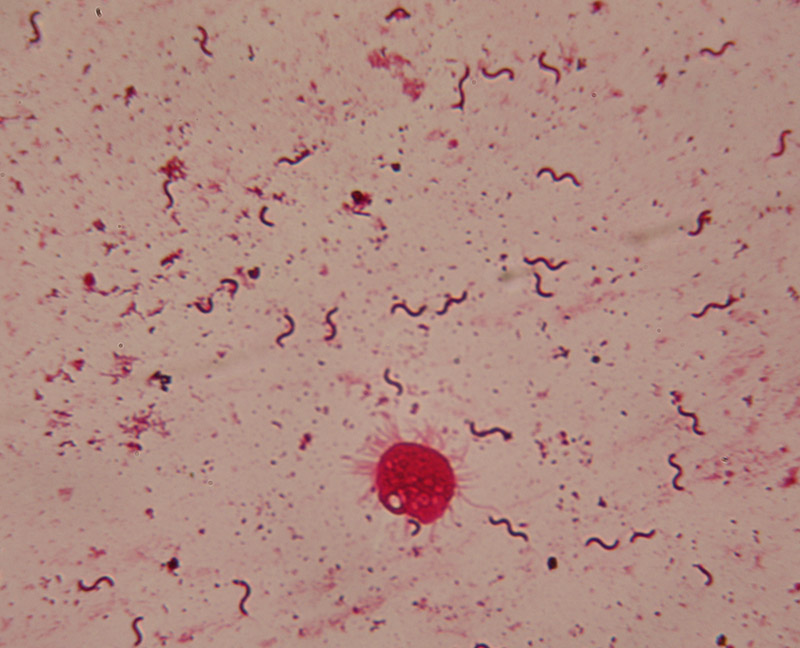
Figure 9.
Spirillum undula stained with Brown's mordant and fuchsin (Figure 4). Bacteria of the genus Spirillum are Beta Proteobacteria (Gram negative). They are generally free-living in many aquatic environments. They are not related to spirochete bacteria. A eukaryotic cell with apparent flagella, presumably an aquatic protozoan, can be seen in the lower center of the image. Photographed with a C-mounted digital SLR camera on a Leitz Ortholux II with 45x objective lens.
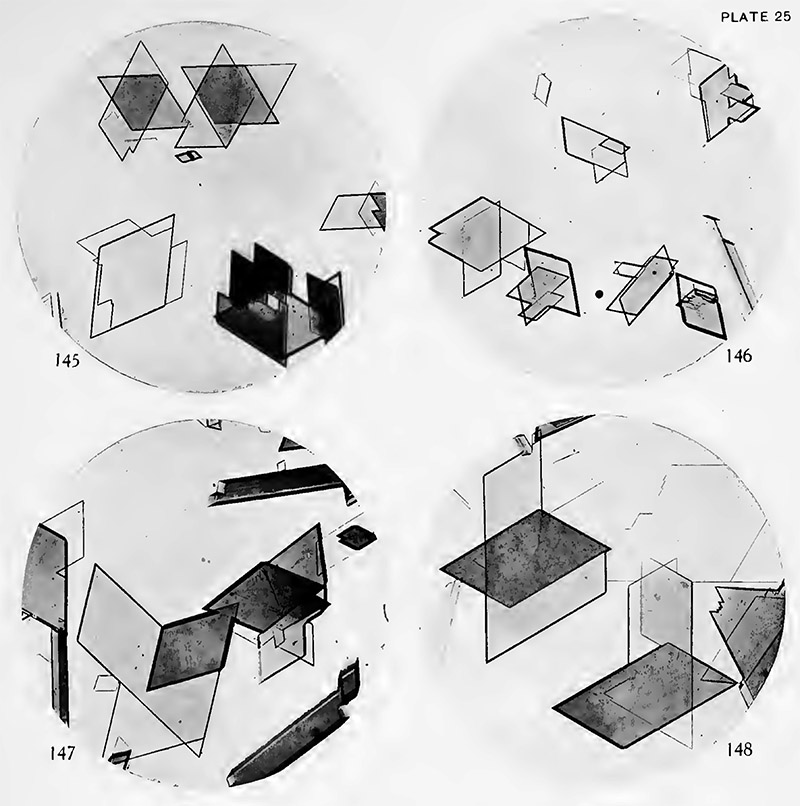
Figure 10.
Photographs of crystals of horse hemoglobin, produced and photographed by A.P. Brown. From Reichert and Brown “The Differentiation and Specificity of Corresponding Proteins and Other Vital Substances in Relation to Biological Classification and Organic Evolution: The Crystallography of Hemoglobins”, 1909.
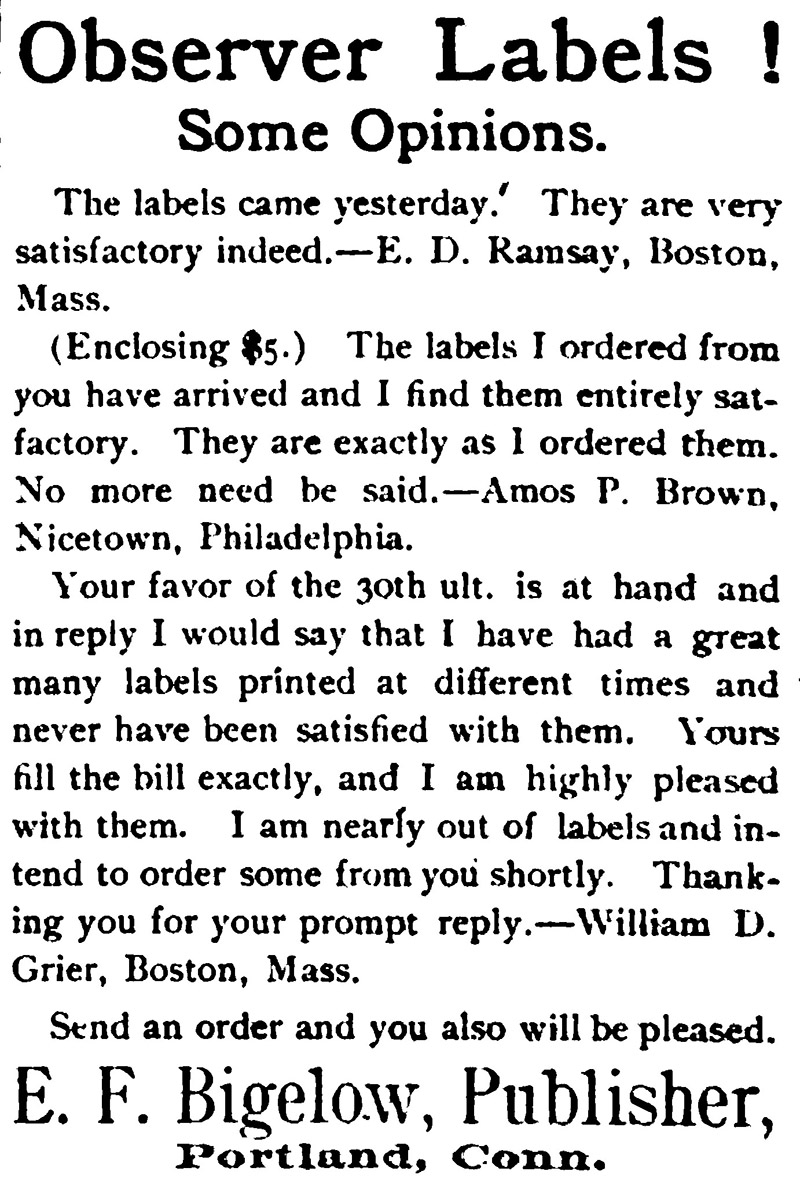
Figure 11.
An 1892 advertisement for labels, which used a testimonial letter from Amos P. Brown. Presumably, Brown obtained his professional-quality slide labels from Bigelow. From ‘The Observer’.
Acknowledgements
Thank you to Tom Schwan and Ted Bernhardt, for sharing images and comments.
Resources
Boone, David R., and Richard W. Castenholz (2001) Bergey's Manual of Systematic Bacteriology: Volume One, Second Edition, Springer, New York, page 153
Brown, Amos P. (1888) Modes of occurrence of pyrite in bituminous coal, Transactions of the American Institute of Mining Engineers, Vol. 16, pages 539-546
Brown, Amos P. (1894) On the young of Baculites compressus Say, Proceedings of the Academy of Natural Sciences of Philadelphia, pages 159-160
Brown, Amos P. (1892) A convenient method of centering covers, The Observer, Vol. 3, page 259
Brown, Amos P. (1892) Brushes for cell making, The Observer, Vol. 3, pages 260-261
Brown, Amos P. (1892) Mounting small insects, The Observer, Vol. 3, page 261
Brown, Amos P. (1892) Staining bacteria to demonstrate the flagella, The Observer, Vol. 3, pages 298-300
Brown, Amos P. (1892) The development of the shell in the coiled stage of Baculites compressus Say, Proceedings of the Academy of Natural Sciences of Philadelphia, pages 136-141
Brown, Amos P. (1894) A comparative study of the chemical behavior of pyrite and marcasite, Proceedings of the American Philosophical Society, Vol. 33, pages 225–243
Brown, Amos P. (1895) Podophyra libera Perty, Practical Microscopy, Vol. 6, pages 65-67
Brown, Amos P. (1908) Jade and similar green stones, Bulletin of the Museum of Science and Art, University of Pennsylvania, Vol. 1, pages 140-145
Brown, Amos P. (1911) The formation of ripple-marks, tracks, and trails, Proceedings of the Academy of Natural Sciences of Philadelphia, pages 536-547
Brown, Amos P., Frederick Ehrenfelt (1913) Minerals of Pennsylvania, Topographic and Geologic Survey of Pennsylvania
Bulletin of the American Institute of Mining Engineers (1918) Obituary of Amos Peaslee Brown, September issue, pages xliii-xlv
Erni, Henri, and Amos P. Brown (1901) Mineralogy Simplified, Third edition, H.C. Baird & Co., Philadelphia
Frazer, Persifor, and Amos P. Brown (1910) Tables for the Determination of Minerals by Physical Properties, J.B. Lippincott Co., Philadelphia
Godfrey, E.L.B. (1896) The Camden Microscopical Society, History of the Medical Profession of Camden County, N.J., A.L. Davis, Philadelphia, page 146
New York Times (1897) Review of Amos Brown’s lecture on Making artificial gems: Methods used by chemists in making diamonds, rubies, and other gems from their constituents, March 7
The Observer (1892) Advertisements from E.F. Bigelow, Vol. 3
Penrose, B.A.F. (1917) Memorial of Amos P. Brown, Bulletin of the Geological Society of America, Vol. 29, pages 13-16
Proceedings of the Academy of Natural Sciences of Philadelphia (1919) Report of the Biological and Microscopica Section, Vol. 71 , page 313
Prowell, George R. (1886) The Microscopical Society of Camden, The History of Camden County, New Jersey, L.J. Richards, Philadelphia, page 339
Reichert, Edward T., and Amos P. Brown (1908) Preliminary report upon a crystallographic study of the hemoglobins: A contribution to the specificity of corresponding vital substances in different vertebrates, Proceedings of the American Philosophical Society, volume 47, page 298
Reichert, Edward T., and Amos P. Brown (1909) The Differentiation and Specificity of Corresponding Proteins and Other Vital Substances in Relation to Biological Classification and Organic Evolution: The Crystallography of Hemoglobins, Carnegie Institution of Washington, Washington, D.C.
Stone, Witmer (1918) Amos Peaslee Brown, Proceedings of the American Philosophical Society, Vol. 57, pages iii-xv